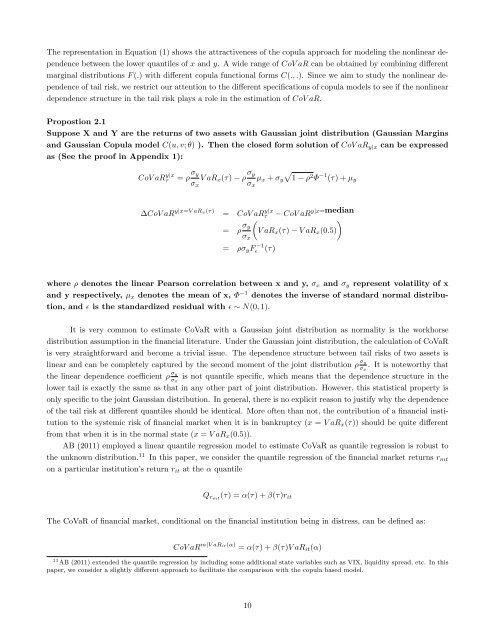Does Tail Dependence Make A Difference In the ... - Boston College
Does Tail Dependence Make A Difference In the ... - Boston College
Does Tail Dependence Make A Difference In the ... - Boston College
You also want an ePaper? Increase the reach of your titles
YUMPU automatically turns print PDFs into web optimized ePapers that Google loves.
The representation in Equation (1) shows <strong>the</strong> attractiveness of <strong>the</strong> copula approach for modeling <strong>the</strong> nonlinear dependence<br />
between <strong>the</strong> lower quantiles of x and y. A wide range of CoV aR can be obtained by combining different<br />
marginal distributions F (.) with different copula functional forms C(., .). Since we aim to study <strong>the</strong> nonlinear dependence<br />
of tail risk, we restrict our attention to <strong>the</strong> different specifications of copula models to see if <strong>the</strong> nonlinear<br />
dependence structure in <strong>the</strong> tail risk plays a role in <strong>the</strong> estimation of CoV aR.<br />
Propostion 2.1<br />
Suppose X and Y are <strong>the</strong> returns of two assets with Gaussian joint distribution (Gaussian Margins<br />
and Gaussian Copula model C(u, v; θ) ). Then <strong>the</strong> closed form solution of CoV aR y|x can be expressed<br />
as (See <strong>the</strong> proof in Appendix 1):<br />
CoV aR y|x<br />
τ<br />
= ρ σ y<br />
σ x<br />
V aR x (τ) − ρ σ y<br />
σ x<br />
µ x + σ y<br />
√<br />
1 − ρ2 Φ −1 (τ) + µ y<br />
∆CoV aR y|x=V aRx(τ) = CoV aRτ<br />
y|x − CoV aR y|x=median<br />
= ρ σ (<br />
)<br />
y<br />
V aR x (τ) − V aR x (0.5)<br />
σ x<br />
= ρσ y Fɛ<br />
−1 (τ)<br />
where ρ denotes <strong>the</strong> linear Pearson correlation between x and y, σ x and σ y represent volatility of x<br />
and y respectively, µ x denotes <strong>the</strong> mean of x, Φ −1 denotes <strong>the</strong> inverse of standard normal distribution,<br />
and ɛ is <strong>the</strong> standardized residual with ɛ ∼ N(0, 1).<br />
It is very common to estimate CoVaR with a Gaussian joint distribution as normality is <strong>the</strong> workhorse<br />
distribution assumption in <strong>the</strong> financial literature. Under <strong>the</strong> Gaussian joint distribution, <strong>the</strong> calculation of CoVaR<br />
is very straightforward and become a trivial issue. The dependence structure between tail risks of two assets is<br />
linear and can be completely captured by <strong>the</strong> second moment of <strong>the</strong> joint distribution ρ σy<br />
σ x<br />
. It is noteworthy that<br />
<strong>the</strong> linear dependence coefficient ρ σy<br />
σ x<br />
is not quantile specific, which means that <strong>the</strong> dependence structure in <strong>the</strong><br />
lower tail is exactly <strong>the</strong> same as that in any o<strong>the</strong>r part of joint distribution. However, this statistical property is<br />
only specific to <strong>the</strong> joint Gaussian distribution. <strong>In</strong> general, <strong>the</strong>re is no explicit reason to justify why <strong>the</strong> dependence<br />
of <strong>the</strong> tail risk at different quantiles should be identical. More often than not, <strong>the</strong> contribution of a financial institution<br />
to <strong>the</strong> systemic risk of financial market when it is in bankruptcy (x = V aR x (τ)) should be quite different<br />
from that when it is in <strong>the</strong> normal state (x = V aR x (0.5)).<br />
AB (2011) employed a linear quantile regression model to estimate CoVaR as quantile regression is robust to<br />
<strong>the</strong> unknown distribution. 11 <strong>In</strong> this paper, we consider <strong>the</strong> quantile regression of <strong>the</strong> financial market returns r mt<br />
on a particular institution’s return r it at <strong>the</strong> α quantile<br />
Q rmt (τ) = α(τ) + β(τ)r it<br />
The CoVaR of financial market, conditional on <strong>the</strong> financial institution being in distress, can be defined as:<br />
CoV aR m|V aRit(α) = α(τ) + β(τ)V aR it (α)<br />
11 AB (2011) extended <strong>the</strong> quantile regression by including some additional state variables such as VIX, liquidity spread, etc. <strong>In</strong> this<br />
paper, we consider a slightly different approach to facilitate <strong>the</strong> comparison with <strong>the</strong> copula based model.<br />
10
















